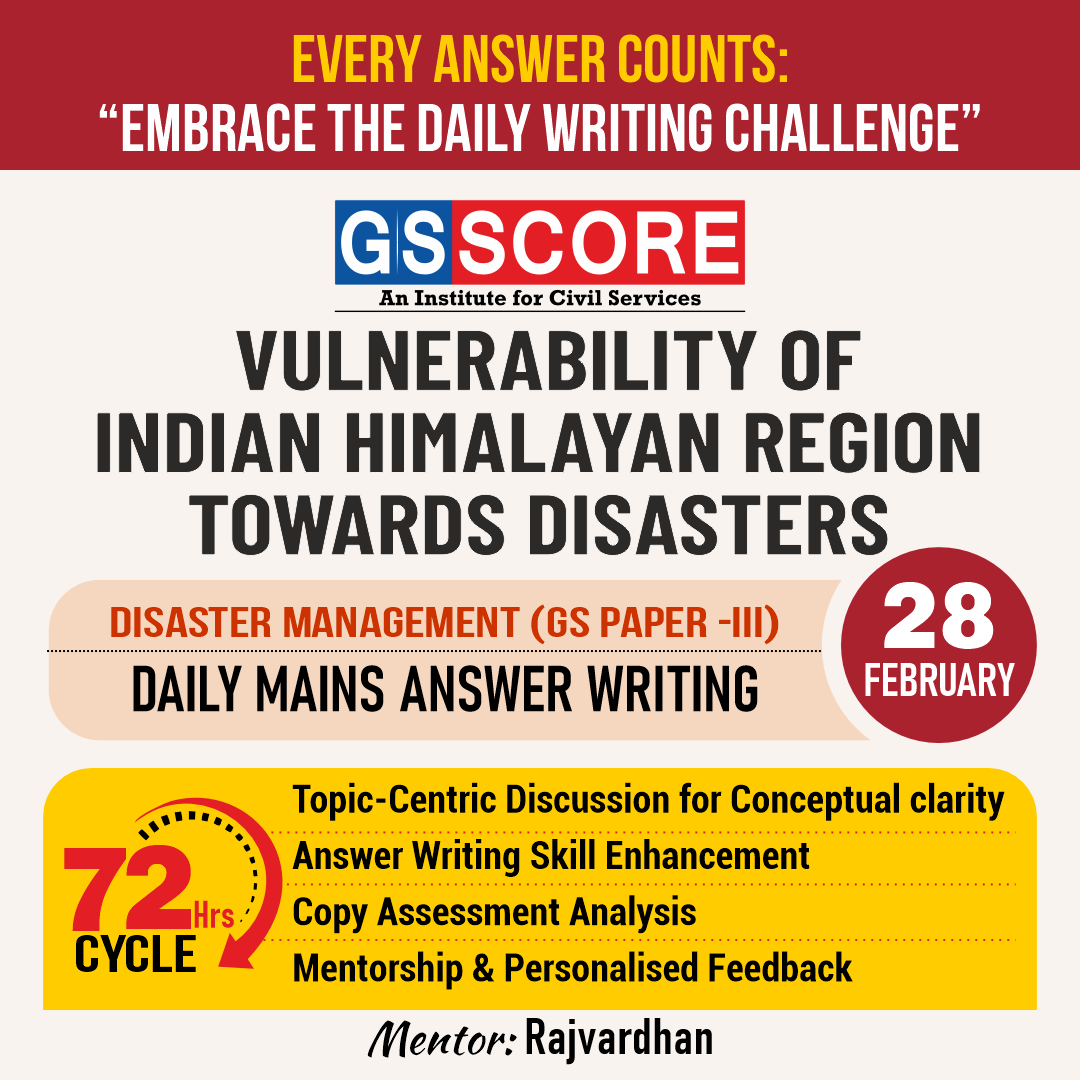


Instruction:
- There will be 2 questions carrying the First Question is-10 marks Write your answers in 150 words and the Second Question is-15 marks Write your answers in 250 words.
- Any page left blank in the answer-book must be crossed out clearly.
- Evaluated Copy will be re-uploaded on the same thread after 2 days of uploading the copy.
- Discussion of the question and one to one answer improvement session of evaluated copies will be conducted through Google Meet with concerned faculty. You will be informed via mail or SMS for the discussion.
Question #1. Discuss the natural and human induced causes of disasters in Himalayas. How Secure Himalayas Project can help in addressing these vulnerabilities? 10 marks (150 words)
Question #2. Discuss the importance of Environmental Impact Assessment of projects especially in Himalayan states. 15 marks (250 words)
(Examiner will pay special attention to the candidate's grasp of his/her material, its relevance to the subject chosen, and to his/ her ability to think constructively and to present his/her ideas concisely, logically and effectively).
STEPS & INSTRUCTIONS for uploading the answers
Step 1 - The Question for the day is provided below these instructions. It will be available at 7:00 AM.
Step 2 - Uploading of Answers : Write the answer in A4 Sheet leaving proper margins for comments and feedback and upload the PDF in MY ACCOUNT section. Click on the option of SUBMIT COPY to upload the PDF.
Step 3 - Deadline for Uploading Answers: The students shall upload their answers by 7:00 PM in the evening same day. The first 50 copies will be evaluated.
Step 4 - Feedback : Mentors will give their feedback for the answers uploaded. For more personalised feedback, join our telegram channel by clicking on the link https://t.me/mains_answer_writing_cse . A one-to-one session will be conducted with the faculty after copy evaluation in 72 Hrs.
Model Answer
Question #1. Discuss the natural and human induced causes of disasters in Himalayas. How Secure Himalayas Project can help in addressing these vulnerabilities? 10 marks (150 words)
The majestic Himalayas, while captivating, are prone to various natural and human-induced disasters that threaten lives and livelihoods. Following are the key causes:
Natural Causes:
• Earthquakes: This region lies at the convergence zone of tectonic plates, making it highly susceptible to earthquakes. These powerful tremors can trigger landslides, avalanches, and infrastructural damage.
• Landslides: Steep slopes, fragile rock formations, and heavy rainfall create an environment perfect for landslides. These unpredictable events often block rivers, destroy infrastructure, and cause casualties.
• Floods: Melting glaciers, heavy monsoon rains, and glacial lake outbursts can cause sudden and devastating floods. These can inundate villages, displace communities, and damage agricultural land.
• Avalanches: Heavy snowfall and steep slopes create ideal conditions for avalanches, burying entire villages and blocking vital transportation routes.
Human-Induced Causes:
• Deforestation: Unsustainable logging practices weaken hillsides, increasing the risk of landslides and soil erosion. This also disrupts natural water flow, contributing to floods.
• Overgrazing: Excessive grazing by livestock damages vegetation, exposing the soil to erosion and increasing the risk of landslides and avalanches.
• Infrastructure development: Construction of roads, dams, and other infrastructure projects can disrupt natural drainage patterns and lead to flash floods and landslides.
• Unsustainable tourism: Unmanaged tourist influx can strain resources, generate waste, and increase pressure on fragile ecosystems, leading to environmental degradation and potential disasters.
Secure Himalaya is a joint initiative by India's government and the UN, aims to protect high-altitude ecosystems in the Himalayas. Launched in 2018, it focuses on:
• Conservation: Preserving snow leopards and other endangered species, along with crucial habitats.
• Livelihoods: Supporting sustainable resource management and economic opportunities for local communities.
• Enforcement: Combating wildlife crime and promoting responsible practices.
This project seeks to ensure the long-term well-being of both the Himalayas and its people. As a result of this dependence on Himalayan resources would reduce as a result of which human induced causes, due to exploitation of himalayan resources, would also reduce.
Question #2. Discuss the importance of environmental impact assessment of projects, especially in Himalyan ecosystem. 15 marks (250 words)
The majestic Himalayas, while boasting breathtaking beauty, are a delicate ecosystem highly susceptible to environmental disruption. This is why Environmental Impact Assessment (EIA) becomes even more critical for any project undertaken in this region.
Himalaya have Heightened Vulnerability due to:
- Fragile ecosystem: The Himalayas are characterized by steep slopes, glaciers, and unique biodiversity. Any development project, even seemingly minor, can trigger avalanches, landslides, and disrupt fragile ecological balances.
- Limited carrying capacity: The harsh environment and limited resources in the Himalayas restrict its capacity to absorb disturbances. Unsustainable projects can quickly lead to resource depletion and irreversible damage.
- Climate change: The region is already facing the brunt of climate change, with increased glacial melt, erratic rainfall patterns, and rising temperatures. Projects that disregard these vulnerabilities further exacerbate the situation.
The EIA provides Protective Shield by helping in:
- Early identification of risks: EIA acts as a proactive tool, identifying potential environmental and social impacts of a project at its planning stage. This allows for mitigation strategies to be incorporated from the beginning, minimizing potential harm.
- Informed decision-making: By providing a comprehensive assessment of environmental risks, benefits, and alternatives, EIA empowers decision-makers to choose the most sustainable and responsible course of action.
- Public participation: EIA encourages public involvement in the assessment process, ensuring transparency, accountability, and local concerns are addressed. This fosters a sense of ownership and promotes responsible development.
In the Himalayas, where development and environmental protection must coexist, EIA plays a crucial role. By rigorously assessing potential impacts, fostering informed decision-making, and ensuring public participation, EIA can help ensure sustainable development that safeguards the delicate balance of this magnificent ecosystem.



